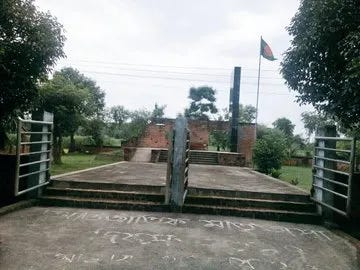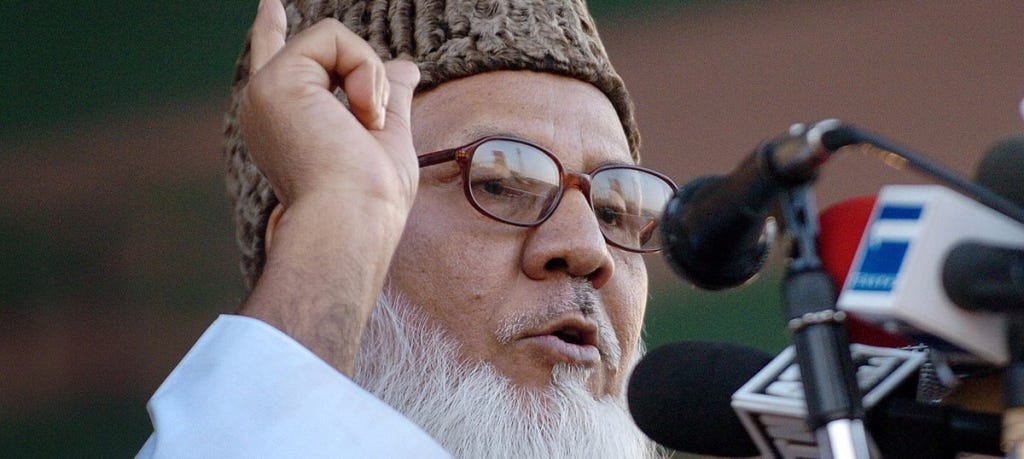The 1971 liberation struggle in East Pakistan, by the Bengali speaking community, was marked by large scale massacres and a terrible genocide, on par with the Holocaust, the Khmer Rouge massacres or Stalin’s forced collectivization. Most of these massacres took place as part of Operation Searchlight by the Pakistan Army to curb the Bangla nationalist movement in 1971, and would lead to the genocide in Bangladesh, that saw around 3 lakh killed, and 10 million fleeing to India as refugees.
Most of these massacres were carried out by “Peace Comitees” basically Razakar outfits, created by the Army to crush the revolt in East Pakistan. These groups were among the most brutal.
It started with the Jinjira massacre by the Pakistan army, at Keraniganj upazilla on April 1. It was used as an ammunition dump by the rebels, and the Pakistan Army marked out this area, after having secured Dhaka by March 25.
The Army moved into Jinjira and began firing, throwing flares on the people from a mosque. The massacre continued for nearly 9 hours. Around 60 people were lined up and shot dead near a pond. Close to 1000 died.
On May 2 the home of Ishan Sarkar,a prominent landlord of Ishangopalpur, was attacked by the Army and Razakars, 29 residents were rounded up, taken to the village pond, beaten, punched and then killed with bayonets. On the same date around 100 Hindus in village of Gabha Narerkathi, of Barisal dt, are massacred by the Pakistan Army and their Razakar collaborators. Most of the victims were lined up and shot dead by machine guns.
Another massacre on the same date at Jandi, Faridpur dt-Pakistani army along with Razakars rounded up the village, to prevent any one from fleeing. Men were killed with machine gun fire, women were raped and killed.
On May 3, around 300 Hindus in Muzaffarabad village of Patiya Upazilla, Chittagong dt, were massacred. The victims included a 5 year old child and an 80 year old man. Around 500 homes were burnt, the culprit was Rameez Ahmed Choudhary. During the Army crackdown, many from Chittagong had taken refuge in Muzaffarabad. The Army bombed Patiya on April 16, captured the town and set up a camp where villagers were tortured to death, their bodies burried.
Muzaffarabad was surrounded by the Pakistani Army and Razakars on May 3, early morning at 5:20. Villagers were dragged out of their homes and shot dead. The victims included 70 year old Rajani Sen who was reading the Ramayana when he was shot dead. Nabin Sadhu, a 75 year old ascetic, who was reciting the Gita too was shot dead. Priests of the local temple were rounded up, forced to break the deities and then shot to death.
Social activist Nirmal Sen was dragged to a nearby paddy field along with his father Upendralal Sen and shot dead. Raimohan a teacher, was tied with a fishing net along with his son and shot. The attackers used to ask the Hindu villagers to recite the Kalma, and on failing to do so were killed. The massacre at Muzaffarabad went on till 2 PM, and the victims buried in mass graves.
In mid May, Ali Ahsan Mojaheed once again led another attack on the Hindu dominated villages of Char Bhadrasan region, in Faridpur subdivision. Around 60 were massacred, while the rest fled to India. 300-350 Hindu homes were looted and set on fire, their properties were seized by the Razakars, in the 3 villages of Baidyadangi, Majhidangi and Baladangi on the Padma river. The victims were mostly peasants, fishermen.
On May 13, Razakars attacked the Hindu dominated part of Bakchar village, and shot dead 9 Hindus, dragging them out of their homes. The culprit here was Ali Ahsan Mohd Mojaheed, who later become MP, and was hanged to death in 2015 for his crimes. On the same date, around 900 Hindus were killed by the Pakistani Army and local Razakars at Demra in Pabna dt, as part of Operation Searchlight.
On May 14, around 200 Hindus were massacred at Baria, under Joydebpur sub division of Dhaka dt, by Pakistani army with the help of local Razakar collaborators. Homes were looted, as the fleeing Hindus were shot at randomly, and only a heavy downpour stopped it.
On May 15, more than 500 Hindus massacred, at Ketnar Bil, Barisal district, by Pakistan army and Razakar collaborators. Deserted homes were set on fire. Around 19 persons of the Patra family were killed, the bodies were dumped in mass graves.
On May 16, Around 33 Hindus massacred at Hasamdia and nearby villages, in Faridpur dt. The local market was set on fire. The culprit was Abul Kalam Azad of the Jamaat-E-Islami who later became a TV preacher too,and was hanged for his crimes in 2013.
One of the largest massacres of Hindus in East Pakistan during by Pakistan Army at Chuknagar, in Dumuria upzilla of Khulna division on May 20. Around 10,000 are estimated to have been massacred.
Chuknagar is located very close to the Indian border. The Hindu refugees had crossed Bhodra river, and planned to cross over to India via Satkhira Road. By May 15, 1971 many Hindu refugees had gathered in large numbers here, planning to cross over. Around 10 AM on May 20,1971, around 10-30 Pakistani army personell, arrived in trucks with machine guns and semi automatic weapons. The firing began at the Pathkola grounds and later to Chuknagar Bazaar, stopped only at 3 PM.
Around 10,000 were estimated to have been killed in what was one of the worst massacres of 1971. Many jumped into the river to save themselves, and a memorial built in tribute.
On May 22, Razakar collaborators attacked the village of Bhimnali in Barisal district, and overpower the Hindu residents who resisted with spears. A group of 500 entered the village, killed around 20, threw the dead bodies in a nearby canal,and looted the homes.
Burunga a small village in Slyhet division of current day Bangladesh. On the afternoon tension mounted in the village over the arrival of the Pakistan Army on May 25,1971.
The local village head Injad Ali, announced a peace committe, and peace cards were distributed to assure the Hindu residents. Residents assembled in the local high school ground around May 26, more than a 1000 gathered. The Razakar collaborators Abdul Ahad Chowdhury and Dr. Abdul Khaleque arrived around 9 AM at the school, with the Pakistani army unit led by Capt Nur-Ud-Din. By 10 AM, they segregated the crowd into Hindus and Muslims.
Muslim residents were made to recite the Kalma, the Pakistani national anthem, and let off. Some of the Muslims were ordered to tie the hands of the Hindu residents behind their backs. One of the captive Hindus Srinivas Chakraborty managed to escape, as also the headmaster Priti Ranjan Chowdhury and Ranu Malakar, from a window. The others were not so fortunate.
The tied up Hindus were bought to the school ground and made to stand in 3 columns of 30 each. Capt Nur Ud Din, ordered the Pakistani army to fire on them, and 90 of them lay dead. The dead bodies were later burnt. Ram Ranjan Bhattacharya a prominent lawyer in Sylhet was shot from behind. The Razakars led by Abdul Ahad Chowdhury and Dr. Abdul Khaleque looted the village and molested the Hindu women.
The Pakistani army arrived the next day, and burried the burnt, half burnt corpses of the Hindus in a pit. Some like Srinibas Chakraborty, Jitendra Baidya and Adhir Malakar survived the massacre, and it was Chakraborty who would narrate the ordeal.
Bangladeshi Hindus fleeing to India, had taken refuge in a remote village of Baushgari under Demra. The Pakistani army along with the Razakars, entered the area cordoned it off. Around night they entered the village, and the horror began. Men were dragged out of their homes and shot dead, while the women were raped and shot dead. Around 350 Hindus were killed in what was one of the terrible massacres. Others would be killed in neighbouring villages.
The mastermind of Demra massacre was Motiur Rahman Nizami, a Jamaati leader, who ironically served as MP from Pabna twice after formation of Bangladesh. He was found guilty and sentenced to death in 2014, and executed on May 2016. was the 3rd minister to be found guilty of war crimes, and hanged. He had actually called the Hindus of Bausbarhi for peace talks, and then got them massacred by the Pakistani army.
Nizami actively supported the Razakars, who aided the Pakistani Army’s reign of terror and genocide in East Pakistan. He was convicted on 8 counts and sentenced to death.
More than 100 were massacred at Barguna on May 29,30, majority of them were Bengali Hindus, rest were Muslim supporters of Awami League. The Army explicitly targeted the Hindu localities of Amtala, Karmakarpatti and Nathpatti, rounded up around 600 residents.
The captives were segregated, the women were taken away gang raped, men were shot dead, or smashed in the head. A prominent businessmen of the town Lakshman Das and a doctor Krishna Das were among the victims.
On September 14, Pakistan army attacked Pomara in Chittagong dt, 18 villagers were tied, taken to reserve forest, and burried alive. Women, children and the elderly were assaulted in most barbaric manner.
Around 30 Hindus massacred by Razakars at Suryamani village of Barisal dt on October 7. The raiders gang raped the women, and the men were lined up near the canal, shot dead. The culprits were Abdur Jabbar Engineer, Iskander Ali Mirdha, Mukul Badshah.
Abdur Jabbar served as MP later, was Vice Chairman of Jatiya party, Iskander Ali would be a leader of the Bangladesh Nationalist Party and Md.Ansari Khalifa was a prominent Jamat-E-Islami leader.









Compilation of such horror is an appreciation of your effort but the tragedy is largely forgotten by the Hindus themselves . The seculars don’t read such a history of Hindu massacre . Where do we go from here